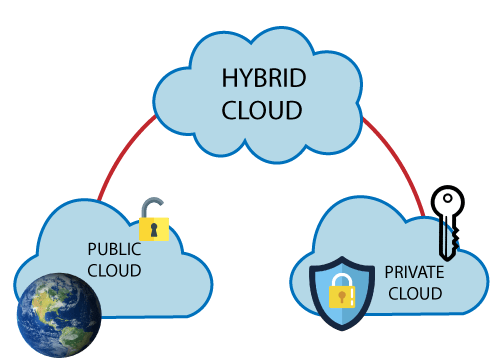As the world is moving towards digitalization, the education sector is also transforming. The old-school way of teaching and learning lessons from physical textbooks in classrooms will never exist in the same way.
Today, a student in one part of the world can take a course or earn a degree from a university located in another part of the world. Especially since COVID-19 hit, the trend of virtual learning from home via computers and mobile devices has spread and revolutionized education.
As a result, students and teachers are now always connected no matter where they are. The technology that is bringing innovation to the education sector is education cloud or education cloud computing.
Cloud computing refers to the on-demand delivery of computing resources, such as servers, storage, software, networking, and analytics. With its enormous benefits, cloud computing has become one of the cornerstones of modern businesses.
From IT, health, and insurance to media and automotive, many industries worldwide now utilize the cloud for storage, data backup, disaster recovery, and more. But how is cloud computing transforming the education sector? Read on to learn about cloud computing in education.
What Is Cloud Computing In The Education Sector?
Cloud computing in education refers to the use of cloud technology to improve students’ learning experiences while lowering costs. The purpose of the education cloud is to help students, teachers, and administrators stay connected while being physically apart.
In other words, cloud solutions for the education sector allow students to study, learn and communicate remotely from anywhere. For example, using education cloud services, teachers can instantly upload learning materials, and students can access them from home over the internet.
Virtual Classroom
Cloud solutions for education have helped schools, colleges, and universities during the COVID-19 pandemic. When schools and colleges closed due to COVID-19, the use of virtual classrooms immediately took off.
Today, many educational institutes still offer online courses and use virtual classrooms. A virtual classroom is essentially an online video conferencing tool with additional features essential for online learning. Most virtual classrooms are cloud-based, allowing teachers and students to connect in real-time and easily collaborate from anywhere.
Some of the most useful features of cloud-based virtual classroom tools include:
- Instructors and students can join the classroom at the time
- Teachers can display learning materials, such as documents, multimedia files, and slide decks
- Students and instructors can interact and collaborate in real-time, both through video and voice chat and text chat
- Students and instructors can record the sessions
- Teachers can create online tests and quizzes
- Teachers can utilize synchronous and asynchronous learning methods via features like video, audio, and chat
- Many virtual classrooms also offer screen sharing and virtual whiteboard features
Cloud Computing In K-12 And Higher Education
The use of education cloud for K-12 and education cloud for higher education is on the rise. Elementary schools, high schools, and universities have implemented new digital platforms that offer benefits like flexibility, easy access, agility, huge cost savings, and modernization. When organizations in the education sector migrate to the cloud, the IT staff in such institutes can also serve students, teachers, and other stakeholders better.
Education cloud providers offer high-performance computing power and advanced tech tools that higher education institutes need to process scientific research. They can also easily share the results with unlimited cloud storage.
Types Of Education Cloud
Here are the different types of cloud that the education sector can utilize:
Public Cloud
A public cloud is a multi-tenant cloud, which means multiple organizations can use computing resources at the same time. However, the data of each tenant is completely isolated from others to ensure data privacy and security.
In other words, each organization can only access its own data, which is invisible to other companies. In public clouds, users don’t have to own, maintain and upgrade the equipment and hardware.
The public cloud is widely used for education-related activities by:
- Allowing teachers to quickly upload learning materials that students access from anywhere
- Enabling students to collaborate on assignments
- Making it possible for teachers to provide feedback in real time
Private Cloud
A private cloud is a single-tenant cloud, which means only one organization can use the computing resources. Organizations can host the private cloud on-premise in their own data centers.
However, a private cloud can also be based on a cloud provider’s infrastructure, but only one organization can access the computing resources over the internet. Educational institutes like schools and colleges use private clouds to store the personal data of students.
Hybrid Cloud

Image source
A hybrid cloud is a combination of a public and private cloud. Organizations can use this type of cloud to store the confidential data of students in the private cloud and less sensitive information in the public cloud. A hybrid cloud allows you to reap the benefits of both public and private clouds.
Ridge Cloud
Ridge Cloud is well suited to meet the needs of educational institutions in search of cloud access. Ridge provides their clients with cloud locations anywhere in the world, and with hybrid/on-prem connection capabilities. For schools or universities who might have to both keep their student data private, but also need to provide cloud-based resources for remote learning, Ridge Cloud would connect these institutions with a local data center partner in their location, to comply with any data regulations and provide hyper-low latency.
Benefits Of Using The Cloud For Education
Cloud computing in the education sector offers a number of benefits:
Accessibility
One of the biggest benefits of the education cloud is that it helps with the seamless delivery of educational content at all times. Instructors can store and share critical resources, like lessons, worksheets, and tests, within a cloud platform with just a click of a button.
As a result, education cloud solutions enable students to access course material and other learning resources anytime and anywhere. For instance, students residing in distant countries can enroll in online courses at colleges in Europe or across the globe. They can even access the course content from mobile devices and participate in group activities, quizzes, etc.
In addition to instant access to learning resources, the education cloud also enables students and teachers to connect instantly. Cloud service companies for the education industry also help streamline processes, which saves time and enhances the productivity of staff and students.
Flexibility
Using education cloud solutions, organizations in the education sector can respond to changes quickly. For example, if a college wants to move to remote learning, it’s easier with education cloud solutions.
Education cloud also provides access to valuable tech tools and enables schools to enhance their tech capabilities. Organizations can scale up and down resources, depending on their need, without buying expensive on-premises servers and computers.
Physical server hardware may not scale if the entire student body needs to log in to attend classes. On the other hand, cloud resources allow schools to easily add more server resources to accommodate the increased demand.
Reduced Costs
Cloud solutions for the education sector help reduce costs in a number of ways. Firstly, colleges, schools, and universities can scale up and add cloud resources as needed. They don’t have to buy expensive hardware, servers, and storage devices. Since schools don’t need to power these devices on-premises, maintenance and electricity costs also go down.
Education cloud solutions also reduce costs for students. When all the required learning resources are available on the cloud, students don’t have to buy expensive books and apps or even live near the campus. Students can live with family or in an affordable area and learn online, instead of needing to live in expensive dormitories or nearby apartments.
Improved Communication And Collaboration
Cloud computing in education allows teachers, students, and parents to connect and collaborate in real-time. Using cloud-based tools like virtual classrooms, teachers can send and receive messages in groups or one-to-one, use audio calls and video conferencing features, share files instantly, mark homework using annotations, and record lessons to improve collaboration and communication.
Innovation
Education cloud solutions enable schools, colleges, and universities to experiment frequently, which in turn, helps them improve learning experiences. For instance, they can develop and deploy new features in their existing apps to make them better. These include features like real-time feedback, chat, etc.
Security And Compliance
Educational institutes need to keep the sensitive data of students and financial data safe and secure. Storing such data in the cloud lets schools take advantage of cloud providers’ state-of-the-art security features.
For instance, data stored on a hard drive could be compromised if the hard drive is stolen. On the other hand, cloud providers use data encryption, data backup, and disaster recovery to secure data.
Additionally, experienced public cloud providers serve a wide range of organizations in the education sector, so they can efficiently meet data compliance requirements to protect students’ personal information.
Features Of Cloud Solutions For The Education Sector
Here are a few examples of what features good cloud-based education solutions provide:
Cloud-based Lesson Delivery Tools
Educational institutes use cloud-based tools specially designed for lesson delivery. These tools allow teachers to deliver lesson content, quizzes, and assessments online. Students can access these learning materials online anytime from their devices.
A complete cloud-based solution for education should offer a range of products to improve collaboration and communication and boost student and staff productivity. It should provide an inclusive learning environment and individual accessibility settings.
Several examples of education cloud solutions that provide easy-to-use tools are:
- Docs, sheets, storage, slides, and more for collaboration
- Classroom and assignments to improve learning experiences and boost productivity
- Chat for better communication
- Calendars and task lists to organize tasks
With cloud-based solutions, you usually don’t have to download the apps on your computer. Instead, you can instantly set up your account and save all your files and documents to the cloud. This way, you can access your documents anytime and anywhere.
Online Courses
Several online course providers use a cloud platform to offer a wide range of online courses from different instructors and universities. For instance, you can take courses related to computer programming, project management, machine learning, and many more from your home. These courses typically include course videos and reading material, graded assignments, and online quizzes.
Cloud-Based Productivity Apps
Students can also use cloud-based productivity apps to take and organize notes. These cloud-based apps let you take notes on your laptop, computer, or even mobile phone and save them in cloud storage. Some apps even allow you to save photos and audio files and sync your data across devices for easy access.
Frequently asked questions (FAQs)
What is an education cloud?
Education cloud refers to the use of cloud technology in the education sector to improve learning experiences for students and lower costs for schools and school districts. When schools hire education cloud consultants to implement cloud-based learning tools, students, teachers, and administrators can stay connected no matter where they are.
What are the benefits of an education cloud?
Cloud computing in education offers many benefits, including scalability, flexibility, quick access to learning resources from anywhere, cost savings, and more.
What are examples of education cloud solutions?
There are many education cloud solutions available today. These include cloud storage for student records, online lesson delivery apps, and productivity SaaS products like calendars and synced notes.













